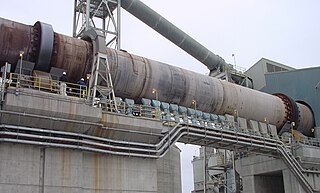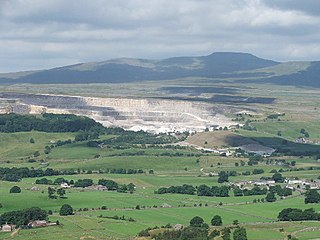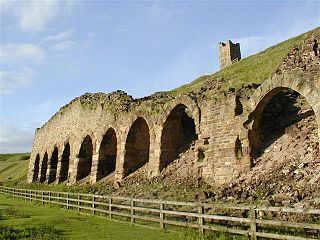
A cement is a binder, a chemical substance used for construction that sets, hardens, and adheres to other materials to bind them together. Cement is seldom used on its own, but rather to bind sand and gravel (aggregate) together. Cement mixed with fine aggregate produces mortar for masonry, or with sand and gravel, produces concrete. Concrete is the most widely used material in existence and is behind only water as the planet's most-consumed resource.

Portland cement is the most common type of cement in general use around the world as a basic ingredient of concrete, mortar, stucco, and non-specialty grout. It was developed from other types of hydraulic lime in England in the early 19th century by Joseph Aspdin, and is usually made from limestone. It is a fine powder, produced by heating limestone and clay minerals in a kiln to form clinker, grinding the clinker, and adding 2 to 3 percent of gypsum. Several types of portland cement are available. The most common, called ordinary portland cement (OPC), is grey, but white Portland cement is also available. Its name is derived from its resemblance to Portland stone which was quarried on the Isle of Portland in Dorset, England. It was named by Joseph Aspdin who obtained a patent for it in 1824. His son William Aspdin is regarded as the inventor of "modern" portland cement due to his developments in the 1840s.

A lime kiln is a kiln used for the calcination of limestone (calcium carbonate) to produce the form of lime called quicklime (calcium oxide). The chemical equation for this reaction is

The Hope Valley line is a trans-Pennine railway line in Northern England, linking Manchester with Sheffield. It was completed in 1894.

Refuse-derived fuel (RDF) is a fuel produced from various types of waste such as municipal solid waste (MSW), industrial waste or commercial waste.

Aberthaw Cement Works are cement works in the Vale of Glamorgan near the village of East Aberthaw in Wales.

Construction aggregate, or simply aggregate, is a broad category of coarse- to medium-grained particulate material used in construction, including sand, gravel, crushed stone, slag, recycled concrete and geosynthetic aggregates. Aggregates are the most mined materials in the world. Aggregates are a component of composite materials such as concrete and asphalt; the aggregate serves as reinforcement to add strength to the overall composite material. Due to the relatively high hydraulic conductivity value as compared to most soils, aggregates are widely used in drainage applications such as foundation and French drains, septic drain fields, retaining wall drains, and roadside edge drains. Aggregates are also used as base material under foundations, roads, and railroads. In other words, aggregates are used as a stable foundation or road/rail base with predictable, uniform properties, or as a low-cost extender that binds with more expensive cement or asphalt to form concrete. Although most kinds of aggregate require a form of binding agent, there are types of self-binding aggregate which do not require any form of binding agent.

Cement kilns are used for the pyroprocessing stage of manufacture of portland and other types of hydraulic cement, in which calcium carbonate reacts with silica-bearing minerals to form a mixture of calcium silicates. Over a billion tonnes of cement are made per year, and cement kilns are the heart of this production process: their capacity usually defines the capacity of the cement plant. As the main energy-consuming and greenhouse-gas–emitting stage of cement manufacture, improvement of kiln efficiency has been the central concern of cement manufacturing technology. Emissions from cement kilns are a major source of greenhouse gas emissions, accounting for around 2.5% of non-natural carbon emissions worldwide.

Blue Circle Industries was a British public company manufacturing cement. It was founded in 1900 as the Associated Portland Cement Manufacturers Ltd through the fusion of 24 cement works, mostly around on the Thames and Medway estuaries, together having around a 70% market share of the British cement market. In 1911, the British Portland Cement Manufacturers Ltd was formed by the addition of a further 35 companies, creating a company with an initial 80% of the British cement market.
Adbri, formerly Adelaide Brighton Cement, is an Australian manufacturer of cement, lime and dry blended products.

The Michigan Limestone and Chemical Company operated the world's largest limestone quarry, which is located near Rogers City in Presque Isle County, Michigan. It was formed and organized in 1910; however, production did not begin until 1912. Ownership of the quarry has changed a number of times; but it is still one of the largest producers of limestone in the United States. The quarry was inextricably interlinked to lake shipping and railroad transportation.
Hima Cement Limited (HCL) is a cement manufacturer in Uganda. It is a subsidiary of the Holcim Group, a building materials manufacturer headquartered in Switzerland, with subsidiaries in over 80 countries.

Ketton Cement Works is a large cement plant and quarry based in the village of Ketton in the county of Rutland in the United Kingdom. Now owned by HeidelbergCement, the plant produces around one tenth of the UK's Portland Cement needs. Ketton works employs around 220 people and is at the forefront of sustainable cement production, namely through the increasing use of non-fossil fuels for the kilns.

Breedon Cement, formerly Hope Construction Materials and later Hope Cement, is a producer of cement, concrete and aggregates in the United Kingdom, founded on 7 January 2013 by entrepreneur Amit Bhatia. Before 1 April 2014, Hope Construction Materials was the trading name for the two entities, Hope Cement Limited and Hope Ready Mix Concrete Limited. The company adopted its current name in 2017.
The south bank of the Humber Estuary in England is a relatively unpopulated area containing large scale industrial development built from the 1950s onward, including national scale petroleum and chemical plants as well as gigawatt scale gas fired power stations.

Breedon Group plc is an AIM-listed British construction materials company headquartered at Breedon on the Hill, Leicestershire, England. In 2016 Breedon became the UK's largest independent construction materials firm following its acquisition of Hope Construction Materials and in 2018 extended its operations into Ireland with the acquisition of Lagan Group.

Portland Cement Works Precinct is a heritage-listed former cement works and limestone quarries and now disused industrial site at Williwa Street, Portland, City of Lithgow, New South Wales, Australia. It was designed and built in various stages from 1890 to 2003. It is also known as Portland Cement Group and Commonwealth Portland Cement Company Ltd. The property is owned by Boral Limited. It was added to the New South Wales State Heritage Register on 3 August 2012.

The Buxton lime industry has been important for the development of the town of Buxton in Derbyshire, England, and it has shaped the landscape around the town.

Horton Quarry is a limestone quarry near to Horton-in-Ribblesdale, North Yorkshire, England. The quarry, which is some 6 miles (9.7 km) north of Settle, has been operating since at least 1889, and produces limestone for a variety of purposes. Stone used to be exported from the quarry by rail, but now leaves by lorry, although there are plans to re-instate the railway sidings. The quarry used to produce its own lime by roasting the limestone in big kilns on the site, but the last of these were removed in the 1980s. Since 2000, the quarry has been owned and operated by Hanson.

The Ironstone mining in Rosedale, was a major mining concern, in Rosedale, North Yorkshire, England. It flourished in the 19th century and ceased in the early 20th, though smaller scale iron workings were in use through the Middle Ages. The ironstone from Rosedale was typically rated at a higher iron ore concentration in the rock than other mines in the Cleveland and North Yorkshire area.




















